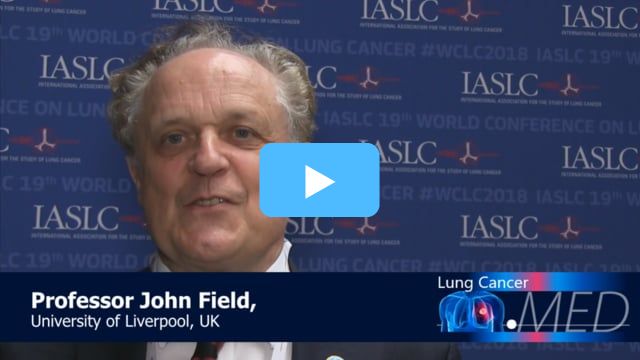Advertisment
WCLC 2018: NELSON – CT screening saves lives

A randomised, controlled screening trial for lung cancer involving almost 16,000 people in the Netherlands and Belgium found that CT screening produced a 26% reduction in lung cancer deaths among at-risk men over 10 years, according to data presented here at the IASLC 19th World Conference on Lung Cancer.
By Thomas R Collins / Interviewer Esther Drain
Professor David Baldwin (Nottingham, UK), Professor John Field (Liverpool, UK), Dr Sanjay Popat (London, UK)
NELSON – the potential to save thousands of lives
The difference was even greater among women — who were not the primary focus and were enrolled at a lower rate — for whom the rate of lung cancer mortality was reduced by 61% to 39% at 8 years to 10 years of follow-up in the NELSON trial.
After 27,000 total screening scans, the positive test result rate was 2.2%, which led to a 0.9% lung cancer detection rate — a positive predictive value for the test of 41%.
“Volume CT lung cancer screening of high risk former and current smokers results in low referral rates…. and a very substantial reduction in lung cancer mortality in both genders,” said Professor Harry de Koning, deputy head of public health at Erasmus Medical Centre in Rotterdam, who presented the findings.
Participants were age 50 to 74, with a smoking history of more than 10 cigarettes a day for more than 30 years, or more than 15 a day for more than 25 years. And they had to have stopped smoking within the last 10 years. An inability to climb two flights of stairs and a weight of 140 kg or more were exclusion criteria, among others.
Patients in the control arm were not screened, while those in the screening arm had CT scanning at 1 year, 2 years, 4 years and 6.5 years.
Cancers in the screening arm were caught much earlier. Similar to population data, less than 10% of the detected cancers in the control arm were Stage 1a, while 50% in the screening arm were at this earliest stage. And about half of the cancers found in the control arm were Stage IV, compared to just over 10% among patients screened.
Professor John Field, professor of molecular oncology at the University of Liverpool, said the findings demonstrate “a major move forward, in my mind, in lung cancer screening.” The official European position on low-dose CT lung cancer screening had been waiting for the mortality data from NELSON.
Professor Field, a member of the team helping formulate the EU’s position statement, said “it would now appear that annual screening is the probably the most likely choice.”
“There is now conclusive evidence for implementation of lung cancer screening – and I’ve aimed this comment specifically at Europe — based on two large, randomised, controlled trials,” including the National Lung Screening Trial in the U.S., with results published several years ago, he said.
Although only 16% of the participants in NELSON were women, the data are compelling, he said. The data suggest that the mortality rate in a trial with 50/50 enrolment would confer a lung cancer mortality decrease of 33% to 44%.
“Do we actually now consider female and male protocols for lung cancer screening and how they are brought into the actual trials?” Professor Field said. “Do we also consider integrated treatment regimens within the lung cancer screening protocols? We should look at the continuity of the individual going through from screening right through the whole life of the disease. And I think this open up enormous opportunities for the future.”
A poster presented at WCLC by researchers at the University of Liverpool showed good results in a screening program aimed at some of the most at-risk areas of England. Liverpool has twice the incidence of lung cancer as the rest of the country, and the program includes “public engagement” events in areas of the city with the highest lung cancer incidents, meant to promote positive messages and address the fear and fatalism that surround the disease. Those age 58 to 70 with COPD, a smoking history or with asbestos exposure were eligible for a lung health check. Those without a COPD diagnosis were offered spirometry testing, and further assessment, with those meeting a 5% risk threshold eligible for low-dose CT scanning.
A total of 2,911 attended the lung health check, with 1,064 CT scans performed, leading to 17 cases of lung cancer. Of 1,658 people without COPD, 726 have had abnormal spirometry and gone on to further testing.
“This innovative project is already improving access to respiratory healthcare in a deprived area of Liverpool,” researchers said, “is identifying new COPD patients, and should improve outcomes for lung cancer in this disadvantage population.”





